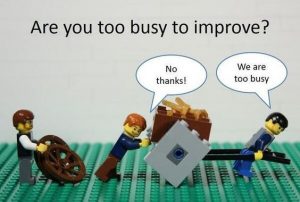The phrase “If it’s not broke, don’t fix it,” is a concept that seems to be very reasonable and is widely accepted by many. If there’s nothing wrong with the end result of a process, then why tinker with the process at all? Spending energy and time on something that does not have an issue would be a waste of time, right?
Maybe not, this form of thinking and attitude negates Continuous Improvement in that there is no improvement, and a process become stagnant. PDCA cannot take place when it’s met with the notion of “what we do works” and “we’ve always done it this way.” Sometimes it’s hard to see how a process can be changed for the better, especially if you believe the current process is also the best process.
Oftentimes, this way of thinking prevents improvement from ever beginning, largely because it’s perceived as a waste of time. Everyone is already busy enough without having to put time into a process that clearly works. PDCA isn’t about whether something works, but more, can it be improved? Time spent towards improvement is an investment, and never a waste of time because it increases the value produced by your process.
Continuous Improvement is not meant as something to point fingers or say that something is being done the “wrong” way. It is meant to allow you to maximize effectiveness and efficiency, to complete your goals and to fulfill a purpose in the best way possible. Improvement should always be looked at in the most positive of light, as it is about evolution and growth, allowing for the best to come out of everything.
